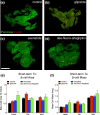Incretin Therapies Do Not Expand β-Cell Mass or Alter Pancreatic Histology in Young Male Mice
- PMID: 28323942
- PMCID: PMC5460937
- DOI: 10.1210/en.2017-00027
Incretin Therapies Do Not Expand β-Cell Mass or Alter Pancreatic Histology in Young Male Mice
Abstract
The impact of incretins upon pancreatic β-cell expansion remains extremely controversial. Multiple studies indicate that incretin-based therapies can increase β-cell proliferation, and incretins have been hypothesized to expand β-cell mass. However, disagreement exists on whether incretins increase β-cell mass. Moreover, some reports indicate that incretins may cause metaplastic changes in pancreatic histology. To resolve these questions, we treated a large cohort of mice with incretin-based therapies and carried out a rigorous analysis of β-cell turnover and pancreatic histology using high-throughput imaging. Young mice received exenatide via osmotic pump, des-fluoro-sitagliptin, or glipizide compounded in diet for 2 weeks (short-term) on a low-fat diet (LFD) or 4.5 months (long-term) on a LFD or high-fat diet (HFD). Pancreata were quantified for β-cell turnover and mass. Slides were examined for gross anatomical and microscopic changes to exocrine pancreas. Short-term des-fluoro-sitagliptin increased serum insulin and induced modest β-cell proliferation but no change in β-cell mass. Long-term incretin therapy in HFD-fed mice resulted in reduced weight gain, improved glucose homeostasis, and abrogated β-cell mass expansion. No evidence for rapidly dividing progenitor cells was found in islets or pancreatic parenchyma, indicating that incretins do not induce islet neogenesis or pancreatic metaplasia. Contrasting prior reports, we found no evidence of β-cell mass expansion after acute or chronic incretin therapy. Chronic incretin administration was not associated with histological abnormalities in pancreatic parenchyma; mice did not develop tumors, pancreatitis, or ductal hyperplasia. We conclude that incretin therapies do not generate β-cells or alter pancreatic histology in young mice.
Copyright © 2017 Endocrine Society.
Figures








Comment in
-
Incretin-Based Therapies: Revisiting Their Mode of Action.Endocrinology. 2017 Jun 1;158(6):1560-1563. doi: 10.1210/en.2017-00252. Endocrinology. 2017. PMID: 28575434 Free PMC article. No abstract available.
Similar articles
-
Marked expansion of exocrine and endocrine pancreas with incretin therapy in humans with increased exocrine pancreas dysplasia and the potential for glucagon-producing neuroendocrine tumors.Diabetes. 2013 Jul;62(7):2595-604. doi: 10.2337/db12-1686. Epub 2013 Mar 22. Diabetes. 2013. PMID: 23524641 Free PMC article.
-
Histological changes in endocrine and exocrine pancreatic tissue from patients exposed to incretin-based therapies.Diabetes Obes Metab. 2016 Dec;18(12):1253-1262. doi: 10.1111/dom.12766. Epub 2016 Sep 26. Diabetes Obes Metab. 2016. PMID: 27545110
-
beta-cell failure in diabetes and preservation by clinical treatment.Endocr Rev. 2007 Apr;28(2):187-218. doi: 10.1210/10.1210/er.2006-0038. Epub 2007 Mar 12. Endocr Rev. 2007. PMID: 17353295 Review.
-
Divergent effects of liraglutide, exendin-4, and sitagliptin on beta-cell mass and indicators of pancreatitis in a mouse model of hyperglycaemia.PLoS One. 2014 Aug 13;9(8):e104873. doi: 10.1371/journal.pone.0104873. eCollection 2014. PLoS One. 2014. PMID: 25119717 Free PMC article.
-
Incretin mimetics and DPP-4 inhibitors: new approach to treatment of type 2 diabetes mellitus.Mymensingh Med J. 2009 Jan;18(1):113-24. Mymensingh Med J. 2009. PMID: 19182763 Review.
Cited by
-
Glucagon-Like Peptide-1: Actions and Influence on Pancreatic Hormone Function.Compr Physiol. 2020 Mar 12;10(2):577-595. doi: 10.1002/cphy.c190025. Compr Physiol. 2020. PMID: 32163198 Free PMC article. Review.
-
GLP-1 receptor agonist-associated tumor adverse events: A real-world study from 2004 to 2021 based on FAERS.Front Pharmacol. 2022 Oct 25;13:925377. doi: 10.3389/fphar.2022.925377. eCollection 2022. Front Pharmacol. 2022. PMID: 36386208 Free PMC article.
-
Incretin-Based Therapies: Revisiting Their Mode of Action.Endocrinology. 2017 Jun 1;158(6):1560-1563. doi: 10.1210/en.2017-00252. Endocrinology. 2017. PMID: 28575434 Free PMC article. No abstract available.
-
Effects of Linagliptin on Pancreatic α Cells of Type 1 Diabetic Mice.J Endocr Soc. 2017 Aug 31;1(10):1224-1234. doi: 10.1210/js.2017-00253. eCollection 2017 Oct 1. J Endocr Soc. 2017. PMID: 29264448 Free PMC article.
-
Increases in bioactive lipids accompany early metabolic changes associated with β-cell expansion in response to short-term high-fat diet.Am J Physiol Endocrinol Metab. 2018 Dec 1;315(6):E1251-E1263. doi: 10.1152/ajpendo.00001.2018. Epub 2018 Aug 14. Am J Physiol Endocrinol Metab. 2018. PMID: 30106624 Free PMC article.
References
-
- Campbell JE, Drucker DJ. Pharmacology, physiology, and mechanisms of incretin hormone action. Cell Metab. 2013;17(6):819–837. - PubMed
-
- Drucker DJ, Nauck MA. The incretin system: glucagon-like peptide-1 receptor agonists and dipeptidyl peptidase-4 inhibitors in type 2 diabetes. Lancet. 2006;368(9548):1696–1705. - PubMed
-
- Xu G, Stoffers DA, Habener JF, Bonner-Weir S. Exendin-4 stimulates both beta-cell replication and neogenesis, resulting in increased beta-cell mass and improved glucose tolerance in diabetic rats. Diabetes. 1999;48(12):2270–2276. - PubMed
-
- Buteau J, Spatz ML, Accili D. Transcription factor FoxO1 mediates glucagon-like peptide-1 effects on pancreatic beta-cell mass. Diabetes. 2006;55(5):1190–1196. - PubMed
MeSH terms
Substances
Grants and funding
LinkOut - more resources
Full Text Sources
Other Literature Sources
Medical

